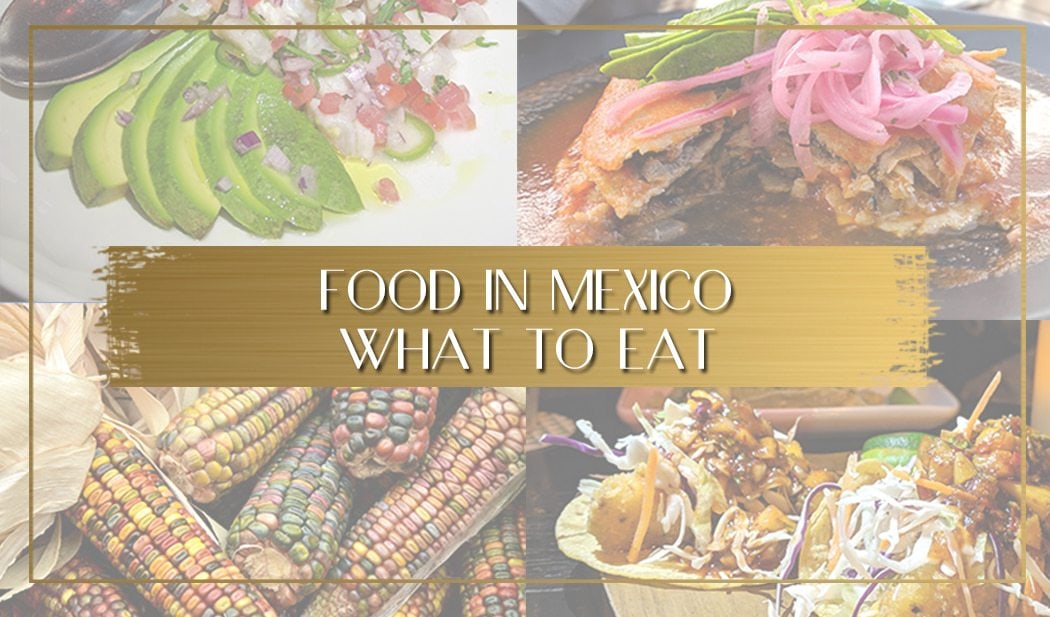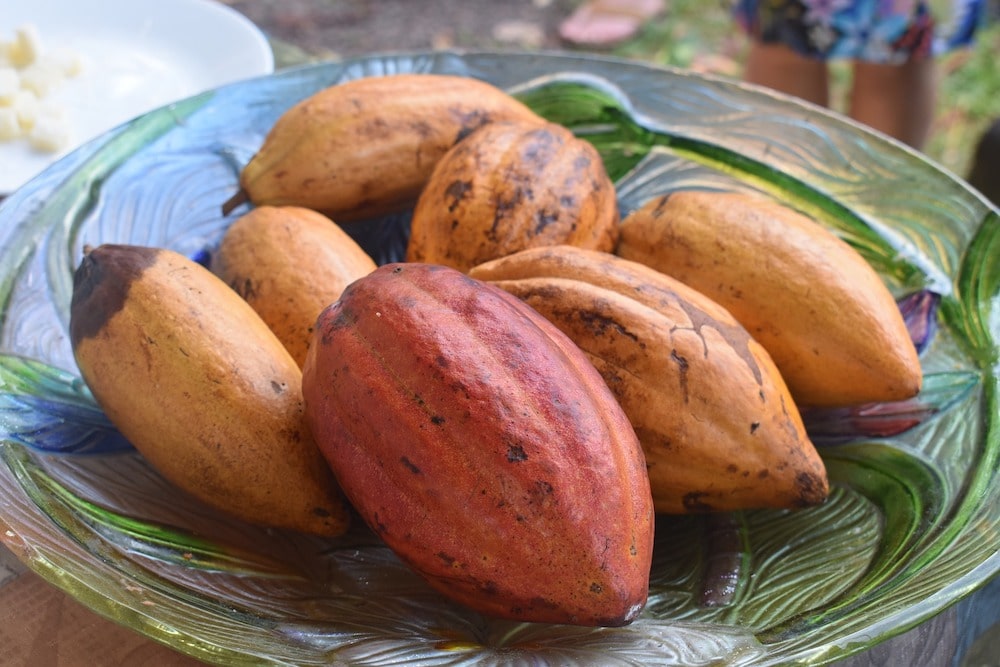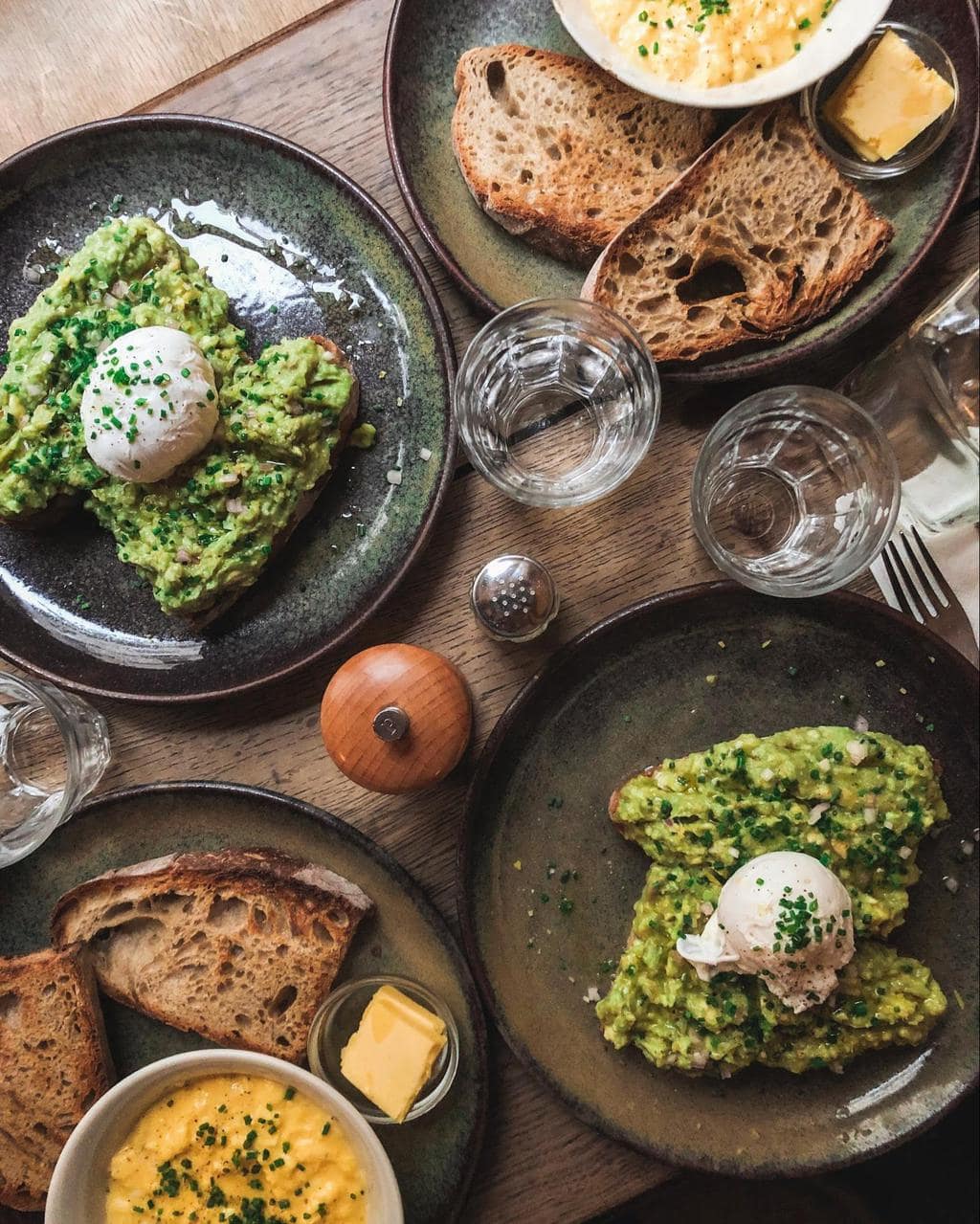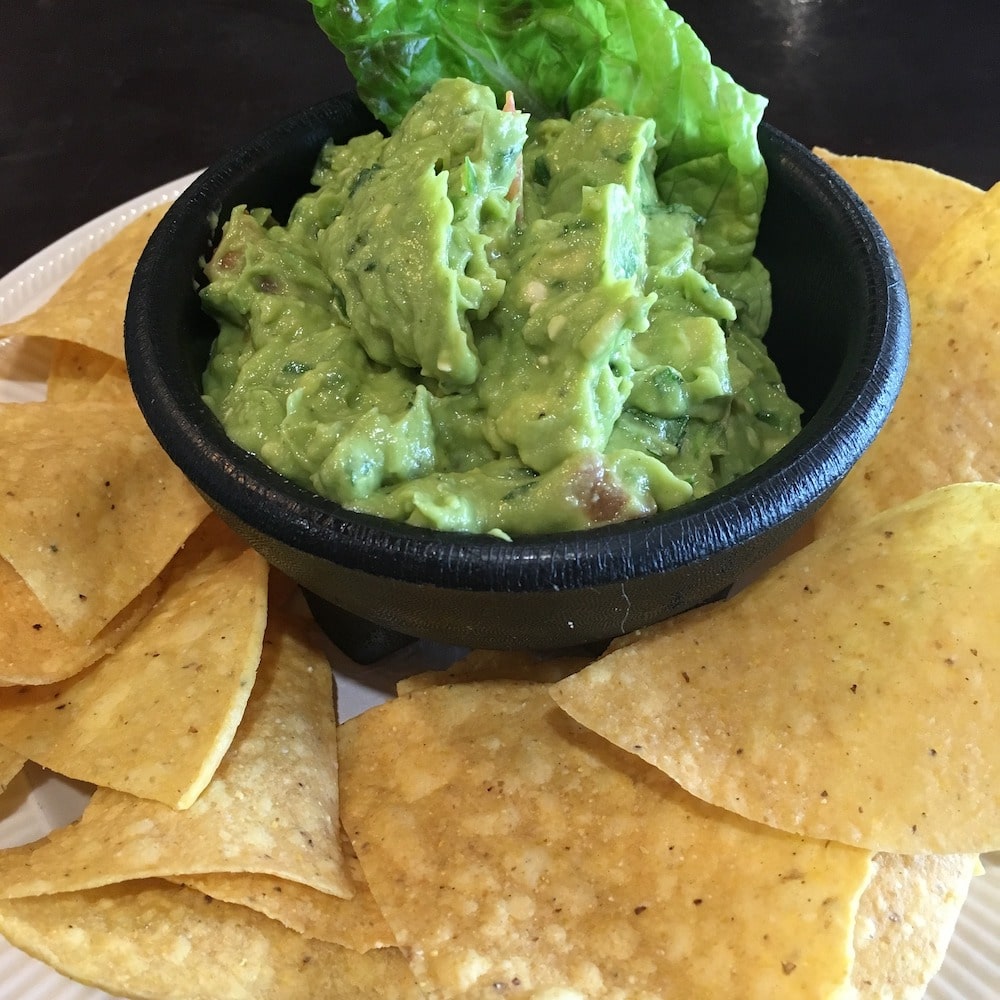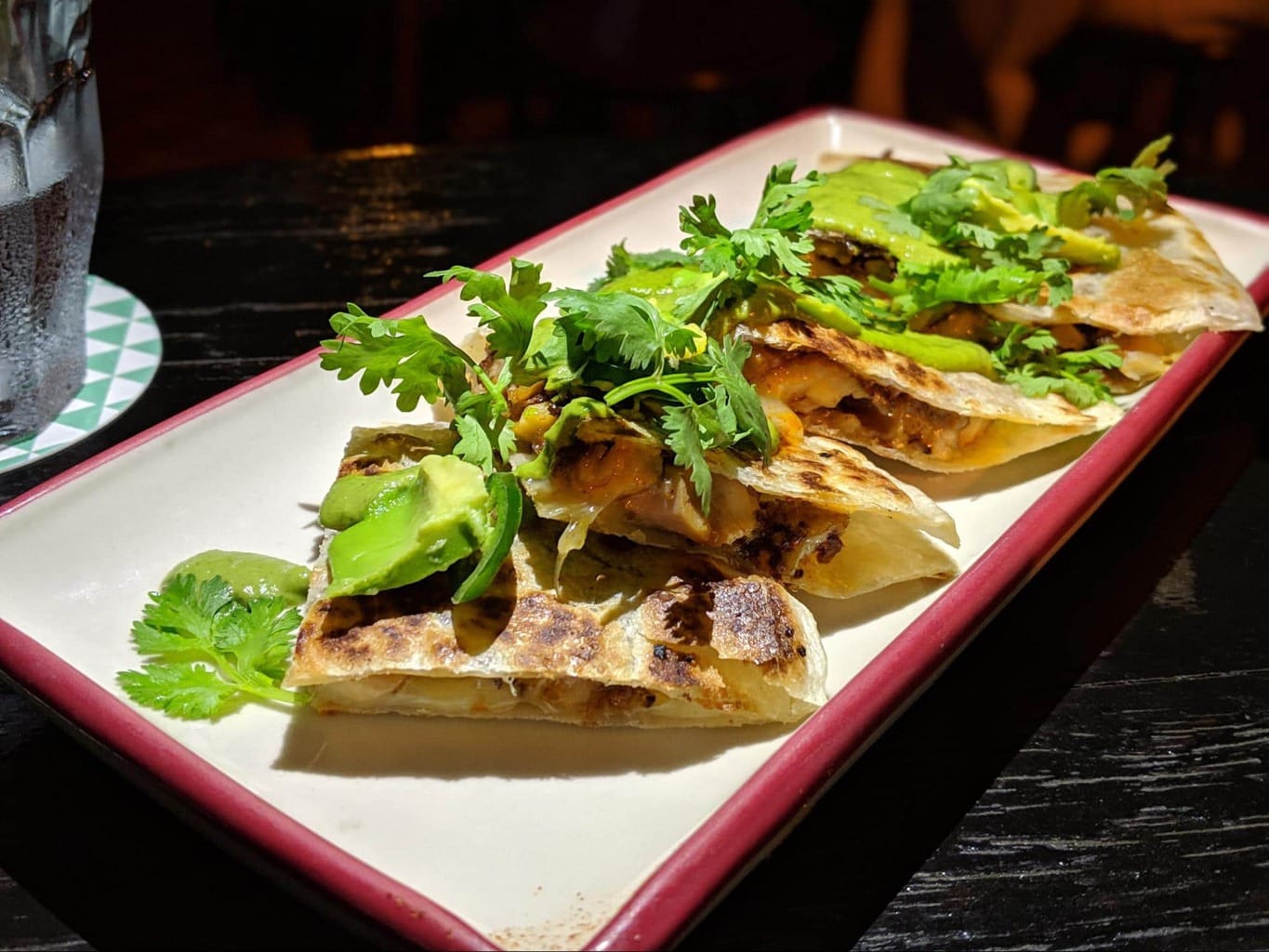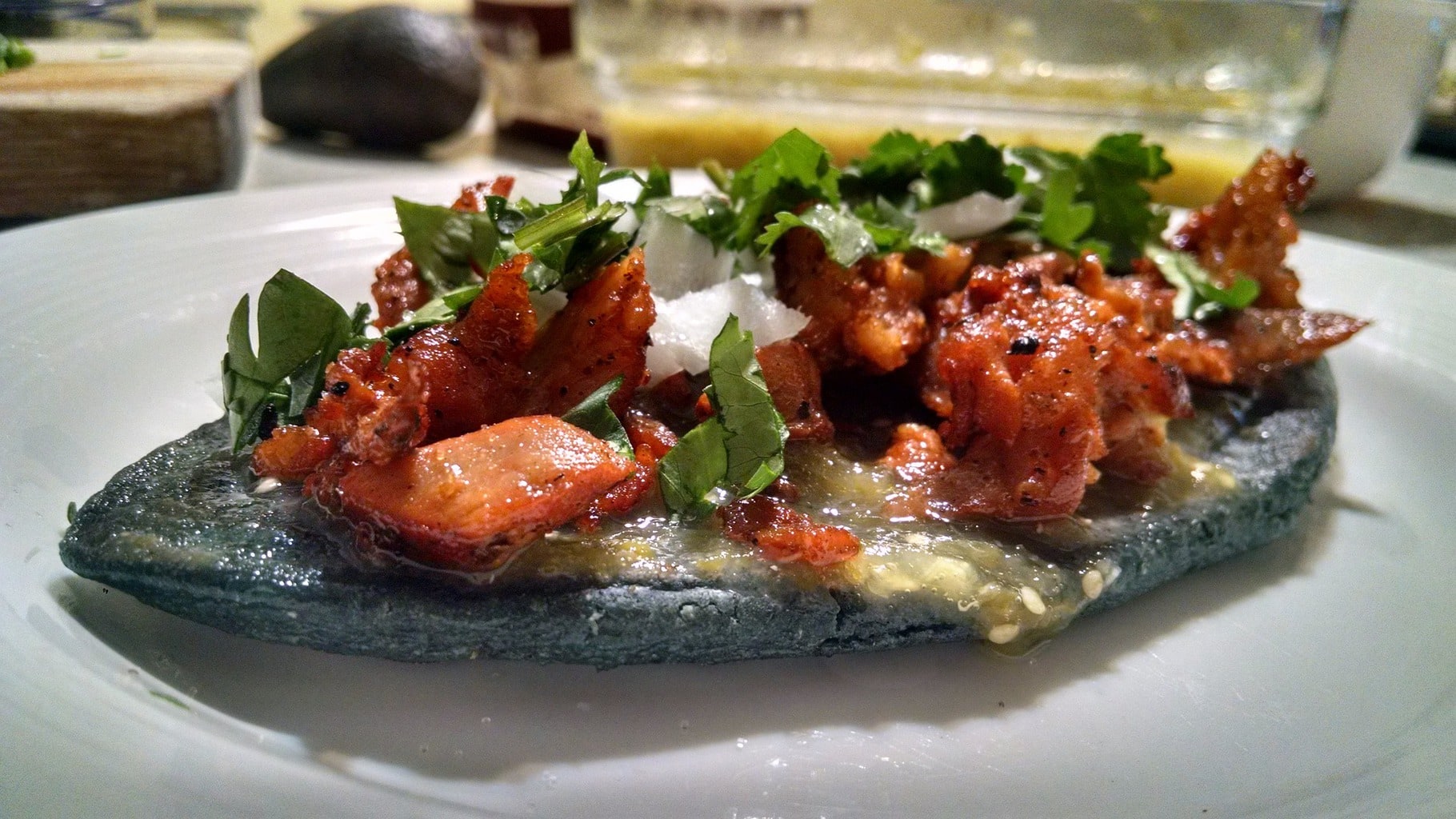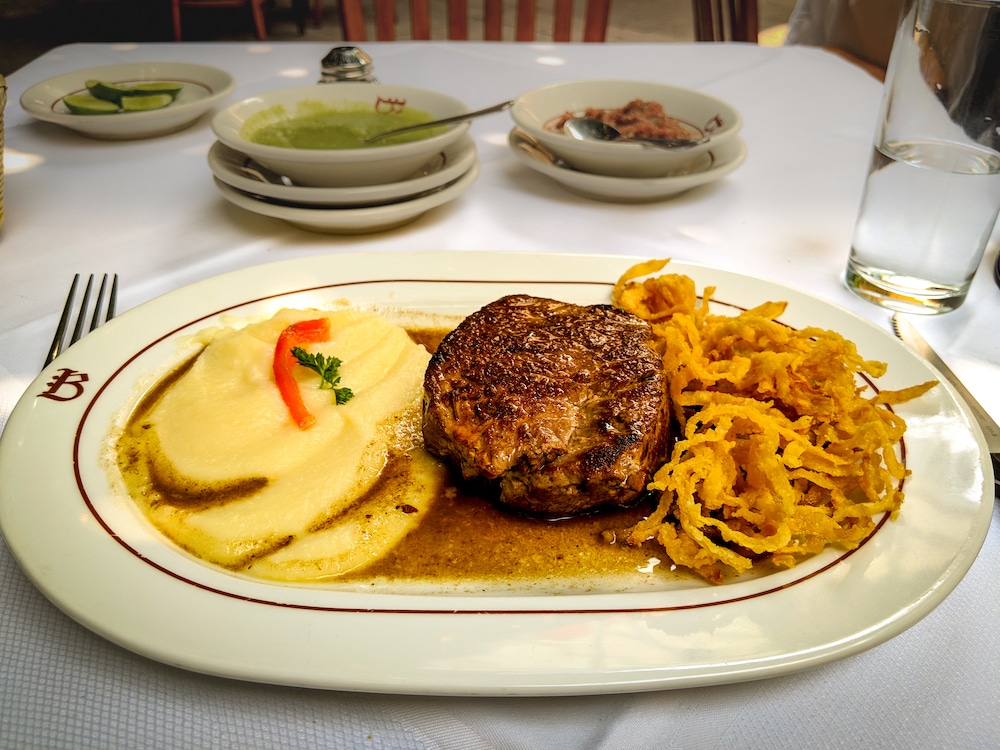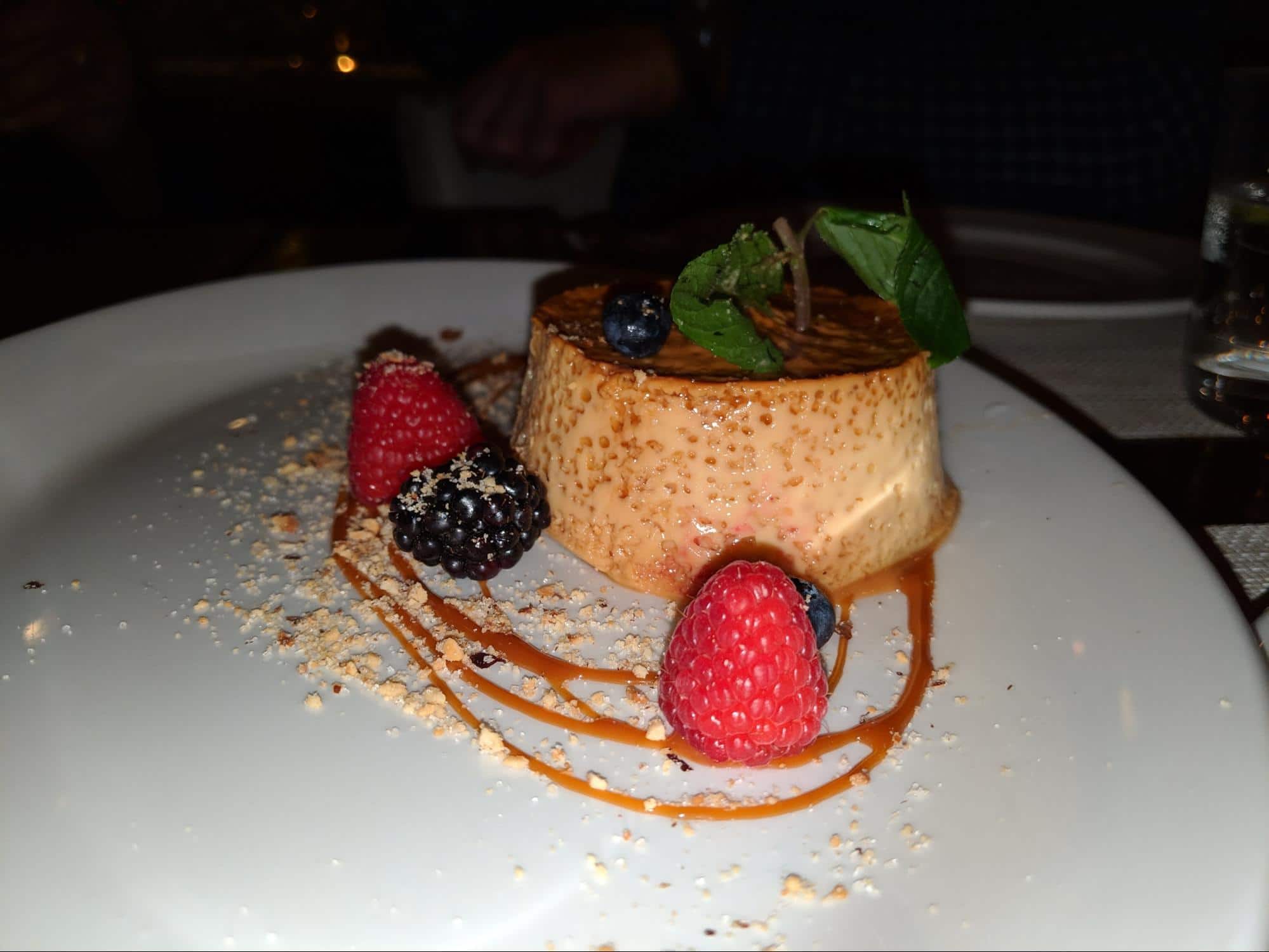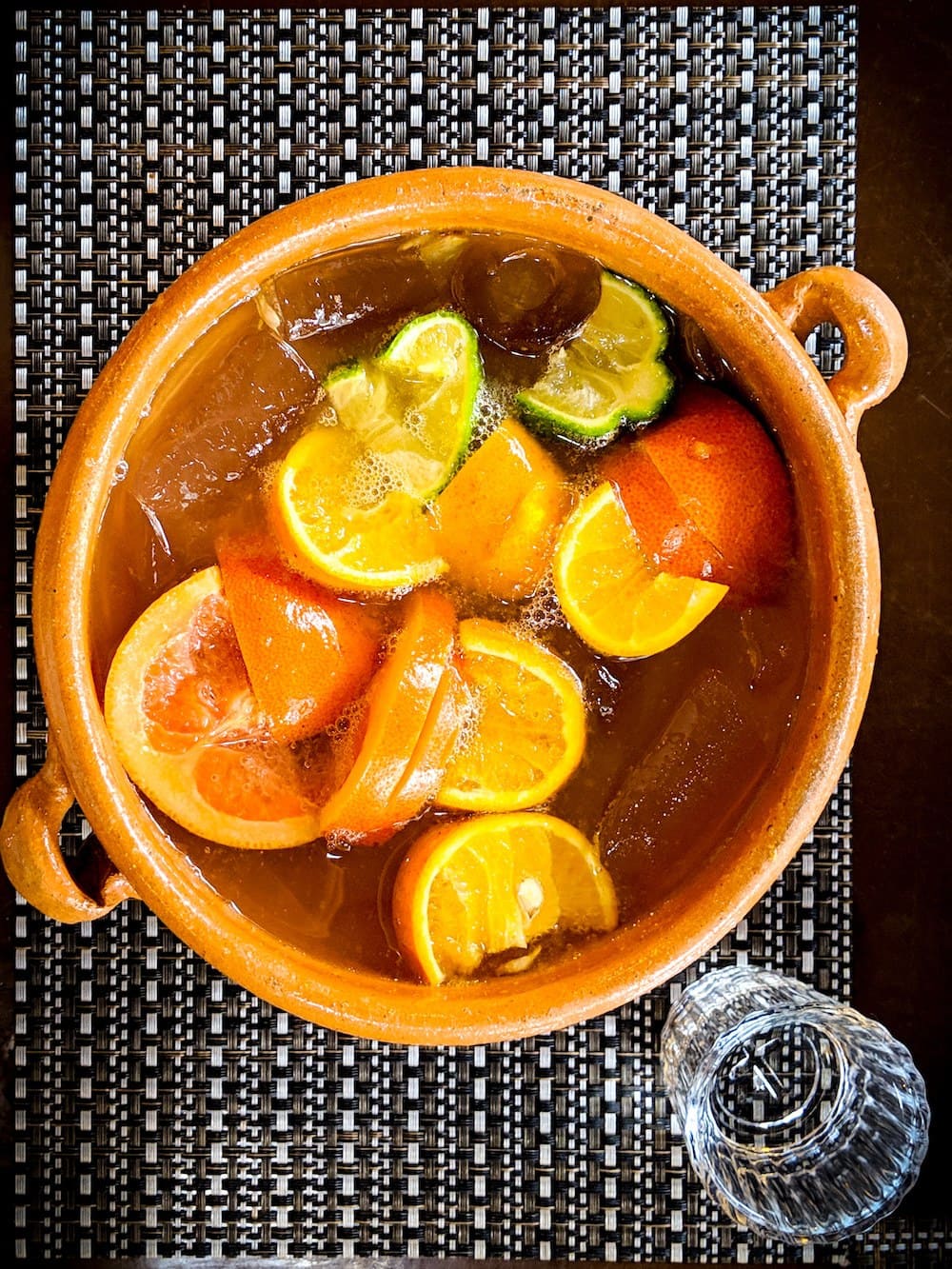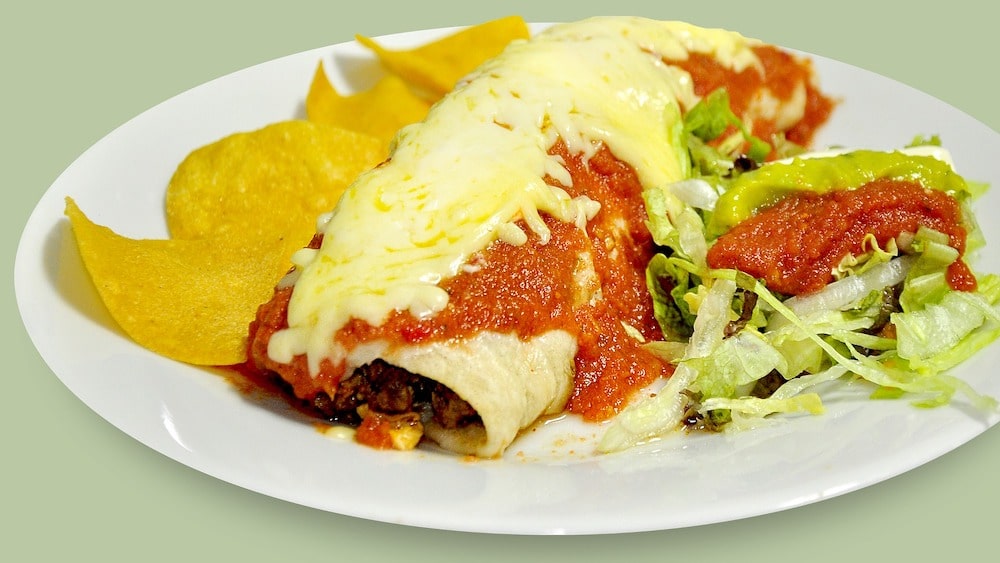
This article was first published in November 2019, and was last updated in June 2020.
Food in Mexico is life. Like in Singapore where I live, or in Spain where I am from, Mexicans love their food and it sometimes feels like sitting down for a meal or grabbing a bite to eat on the go is what they live for.
It does not surprise me, as Mexican cuisine is one of the most widely available and adored by foodies around the world.
Just as much as you can find an Italian restaurant in any city, you can also find a Mexican one.
But don’t take my word for it, UNESCO thinks so too and they have included authentic Mexican food as part of Humanity’s Intangible Cultural Heritage list together with other iconic cultural expressions like tango, the Carnival or the food of the Mediterranean.
It is not only because everyone loves authentic Mexican dishes that the food in Mexico achieved UNESCO recognition, but because Mexico’s most famous foods are also the result of the country’s mixed heritage and the preservation of age-old traditions, ingredients and farming techniques that were original to the pre-Hispanic civilizations.
Mayan and Aztec foods
Mexican recipes have evolved through the mestizaje that occurred when the Spanish Conquistadors arrived exactly 500 years before 2019, but at their core, they rely on the same ingredients that fed Mesoamerican civilisations all those centuries ago.
Did you know that the Spanish words for tomato (tomatl), chocolate (chocolatl) and avocado (ahuacatl) come from the Aztec Nahuatl language? Or that the Mayan holy book, Popul Vuh, stated that humans were created from an ear of corn, their bodies made from massa (corn dough)?
The Spanish spread these Mesoamerican foods to the rest of the world through the trading routes established from the 16th century on and this is how they became global foods planted everywhere.
We can also thank the Mesoamerican people for other staples such as potatoes, squash and corn, an ingredient as versatile as the number of diets that rely on it.
The Aztecs and Mayans domesticated the crop and this was the basis for their diet. Maize was soaked in an alkaline solution and grounded to be used as a sort of flour or dough that represented the basis for many of the dishes that are still popular today.
Although there was a type of corn that was predominant then, there are 59 endemic varieties of corn in Mexico today. They even come in red and purple colors, some are like the rainbow. You cannot have a meal in Mexico without eating corn in various shapes and forms.
There are the crunchy fried totopos or corn chips that you get as a snack, then the tortillas that are served as accompaniment to every dish and used to wrap food, the steamed corn used to make tamales, or the fried tortillas that form the basis for many Mexican street foods such as tostadas. Corn is even poured into drinks and tortilla soup is a thing.
After a few days in Mexico, you will notice that corn is the center around which traditional Mexican dishes are built. Add some beans, usually the pink frijol type, and lots of chilli and you have the Mayan and Aztec diet, unchanged for centuries.
If you don’t believe me, look at the infographic below, where you can see what all the typical Mexican dishes are made of and you will realise that corn is used in pretty much every dish.

Every famous Mexican dish uses corn.
So now you know where food in Mexico comes from, but what of the Mesoamerican diet has been preserved? A whole lot!
Just look at the list below and you will see how prominent chilli, corn, beans, tomatoes and avocados are in today’s Mexican food. You probably already noted that when you were reading the previous sections.
There are also some ingredients that are pervasive in today’s Mexican cuisine but which did not exist before the arrival of the Spanish. Pork, chicken, beef and its by-products, like cheese, milk or cream, were an import that the Mayan and Aztecs did not consume.
And there are also some false friends.
In the last section of this article you will find some of the most famous foods in Mexico which are not actually Mexican but Tex-Mex, you have the southern part of the US to thank for margaritas, burritos and fajitas.
Next time you visit Mexico you will notice that locals drink Tequila mostly straight in shot glasses or with water and that burritos and fajitas are not really on any menu. Now you know why.
Important Mexican food words
Before we dive into the best foods in Mexico to try, it is important to understand some concepts that you will see over and over again in Mexican menus. Even to a native Spanish speaking person like me, the Mexican menus were a total mystery.
I would sit down and spend quite a lot of time going through Google searches of what each dish meant. This is because a lot of foods in Mexico are named after Nahuatl words, not Spanish, and because Mexicans use a lot of words we don’t have in Spain to refer to starters, snacks and other elements.
Antojitos
Literally translated as small cravings, antojitos usually refer to Mexican street foods. However, don’t let the name distract you, these are also found in most menus and are not necessarily snacks. On a restaurant menu, antojitos will usually refer to starters or appetizers but don’t let them fool you, the size is usually enough for a person like me to be full.
To make things clear, I liked to associate antojitos with tapas, as in smaller plates with foods that can be eaten alone or shared, though in the case of Mexican antojitos, you can almost always eat them with your hands.
A clue to define an antojito, is the use of corn as the basis for it, because it helps as the vessel on which the food is delivered and eaten, be it a tortilla (the most common one) or a tamal.
However, bear in mind that Mexicans love to eat, and street food stalls sell pretty much anything, from easy tortilla based items with a topping to complex stews or soups.
Almost all authentic Mexican foods can be found for sale in the street. And they are available all day. I felt as if Mexicans were eating all the time (perhaps true) and one could never be too far from some sort of antojito.
Botanas
This is the word used in Mexico to refer to snacks. But like with Antojitos, Botanas are not necessarily snacks as you and I think of a snack, a bite-sized small food, sometimes they can be quite filling.
Generally, botanas are eaten between meals or when watching a sports game and not as part of a meal, although you will also see the word in menus across the country to refer to that. Tortilla chips are common botanas.
Molcajete
A molcajete is technically a large, heavy and solid stone mortar used in Mexico to blend and ground spices, nuts etc. but on restaurant menus, a molcajete refers to a dish that is served on a mortar. That could be anything, but the Mexican version of a ceviche tends to be common.
Molcajetes can also be filled with meat stewed or even fruits as dessert.
Food in Mexico: traditional Mexican breakfast dishes
Breakfast is a serious affair in Mexico and one that you should take seriously. If you start the day on the right foot you are sure to be better prepared for anything that is to come.
The Mayan and Aztecs also learned to domesticate turkeys and enjoyed their eggs, so to reminisce this grand civilisation, make sure that your breakfast includes some.
Chilaquiles
My Mexican friends all love to start the day with some freshly made chilaquiles. While this may sound like an oxymoron in itself, chilaquiles are made with old tortillas, the repurposing of leftovers gives the tortillas a new life.
Old corn chips or tortillas are toasted or fried to give them a crunchy consistency then a generous amount of red or green sauce is poured over until everything is covered and swimming in it making it a messy and delicious Mexican breakfast.
Toppings are added after to taste but will most likely include an egg (remember the turkeys?), grated cheese and even some kind of protein (maybe chicken).
You can add mashed beans, mole (we will talk about that later) or sprinkle fresh cream for color and flavor. There is no better way to start the day than with a flavor and calorie bomb like this.
This Mexican breakfast dish sounds easy enough but the sauce can make or break a serving of chilaquiles. Sauce can be either red or green, both are made with tomatoes and both are spicy, but the red tends to be more fiery while the green is a bit more forgiving. If it is not flavorful, the chilaquiles fall flat on the plate.
Chilaquiles sauce needs to be runny, is prone to staining your clothes, and in a few minutes it will soak the tortilla which will lose its crunchiness, so you have to devour your feast quickly.
Huevos veracruzanos
Besides the ingredients discussed in the previous sections, eggs are one of the most prominent foods in Mexico and a staple Mexican breakfast item.
The Mayan and Aztecs had already domesticated turkeys when the Spaniards brought chicken over so eggs were eaten pre-Hispanic times.
In Mexico, eggs are usually eaten fried or in scrambled / omelette form, and can be served in a variety of ways. Generally, what surrounds the eggs determines where they come from and its name.
One of the most typical Mexican breakfast egg dishes is in the style of coastal Veracruz. This is the city where Hernan Cortes first disembarked in Mexico in 1519 and several popular Mexican dishes, usually seafood-based and with Caribbean influences, come from here.
Veracruz style eggs are a sort of egg taco: scrambled eggs wrapped in tortillas and covered in black bean or frijole sauce then some cream to add color and a touch of freshness. The black sauce can also include some chorizo or meat.
Huevos divorciados
I was heading to Mexico City and my Mexican friend told me she dreamed of breakfast at El Cardenal, a historic restaurant that happened to be 5min away from my hotel. It was 6am when jetlag slapped me in the face and I was up as the sun was coming up on the Zocalo and the many daily demonstrations right in front of the Government building, and my windows at the Gran Hotel Ciudad de México.
My previous night’s in-flight meal felt miles away, and all I could think of was having breakfast, and her recommendation came in handy: “order huevos divorciados, concha y crema and atole”. I am a native Spanish speaker, and I had no idea what she was talking about apart from the fact that it was featuring some eggs.
You will have to continue reading for the concha, but Huevos Divorciados, or divorced eggs, are another great Mexican food, ideal if you don’t want to make your mind up: two eggs, each covered in either red or green sauce and separated by a line of chilaquiles, or fried tortilla strips, and grated fresh cheese.
Sprinkles of cream, onion or chilli can also be added, and some can even include mashed frijoles. Tortillas will be served with them too, so you can make your own egg taco.
This dish is messy, and since the tortillas don’t really soak the sauce or the egg like bread can, it can all become pretty runny after a while, but oh so satisfying.
Mexican eggs
For the ultimately patriotic Mexican breakfast dish you can’t go wrong with a serving of Huevos a la Mexicana, or Mexican scrambled eggs.
The dish is doubly nationalistic in its ingredients (eggs, tomatoes and chili) and in its colors. When it comes to your table you will understand its name: green from the chilli, red from the tomatoes and white from the chopped onion, the Mexican flag on your plate.
Conchas y panes dulces
When my friend told me I should order a concha and some panes dulces for breakfast, which El Cardenal makes fresh everyday and runs out of quite quickly, I was unsure what this was.
Sweet breads were somewhat an obvious breakfast item, but a concha, in Spain, is a conch shell, and I could not picture how they would make their way onto my Mexican breakfast plate.
It all became clear when the waiter brought over a tray of freshly baked sweet breads and pastries with a frosted, conch-shape, sugar-topped at the forefront.
Conchas are less sweet than what a sugar glazed frosted may sound like, and terribly fluffy inside, they epitomise Mexico’s sweet tooth indulgence and make for one of the most delicious foods you can try in Mexico. I could have had one every morning.
I managed to remove some of the sugar, and ordered a side of crema, as suggested by my friend. Along came a runny and clumpy serving of fresh cream, a mix between curdled and plain milk, which I was to scoop out with a tea spoon and pour all over the pastry.
It was tasty, if somewhat messy, and quite satisfying, but I preferred the concha on its own. There is a wide variety of sweet breads on offer in Mexico and pastries are a prominent part of the local’s breakfast so, if savory pick me ups are not your thing, this is a great alternative.
Sincronizadas
Sincronizadas are breakfast quesadillas that have been filled with ham and cheese. You will have to wait for a bit to read more about quesadillas, but I am pretty sure that you have already tried this most authentic Mexican food before.
They are the Mexican version of the Spanish bikini or the Argentinian ham and cheese sandwich only with tortillas instead of bread and they are deliciously good, one of the simplest and tastiest things to eat in Mexico.
Food in Mexico: snacks (botanas)
Botanas is a word that refers to some of the most authentic Mexican foods: the snacks. Mexicans seem to be eating all day long. Sitting down for some snacks and a drink with friends is one of the most important pastimes and a great way to socialise.
Some of these snacks are also eaten at sports games, and Mexicans are huge soccer fans, others with a cold beer and some at the start of a meal, as you wait for the rest of the Mexican food to arrive.
Totopos or nachos?
You may have been wondering why I have not yet talked about perhaps the most famous food in Mexico, but now is the time, let’s talk about totopos, nachos and tortilla chips.
Firstly, let’s differentiate each. A totopo can be translated as tortilla chip, but not all tortilla chips are totopos because the original totopo is made from tortillas whose corn has been processed, while not all the tortillas used to make chips were made in that process, but rather industrially and directly from masa (rather than from tortillas).
Tortilla chips were invented in Los Angeles in the 1940s at a tortilla factory as a way to make the most of the rejected tortillas.
To simplify, let’s assume totopos are tortilla chips.
Nachos are tortilla chips covered in melted cheese and sliced jalapeno chillies, and sometimes other toppings such as frijoles, cream, meat or onion. They are not really a traditional Mexican food but were invented in-country right across the border from the US in a town called Piedras Negras.
Legend says that, one night, a restaurateur was asked to prepare a snack for the wives of US military personnel after closing time and all he had was some nachos with cheese and slices of jalapenos which he warmed up in the oven. Since his name was Nacho (short for Ignacio in Spanish) the snack was called Nacho’s especiales.
Leaving anecdotes and history aside, totopos are fried, baked or toasted pieces of tortilla, usually triangular in shape, but they can also come in irregular shapes. Industrial ones are most likely fried as that is the simplest way to cook them, and they date back to Mesoamerican times. Aztec soup, or tortilla soup discussed below, was already made with golden totopos.
Notice that a whole fried tortilla is a tostada, whereas a sliced and fried tortilla is a totopo, shape matters here.
While totopos are the best companion to guacamole, they are more widely eaten with salsa or even just chilli sauce as a pre-meal snack. In many parts of Mexico, totopos will arrive at your table, whether you order them or not, along with chopped onions, chilli sauce and maybe mole or bean paste, and they tend to be complementary.
I used to joke with my tour companions in Mexico that it was impossible to eat traditional food in Mexico and avoid eating corn in some form or another because, even if I never ordered them, totopos would arrive as soon as I sat down and tortillas would be served, as bread is in Europe, with every dish.
Guacamole
Guacamole is my favorite Mexican food and you could argue it is the most popular Mexican dish featuring in every single menu.
It is tasty, healthy (though high in calories) and a great complement to pretty much any typical Mexican dish, adding a touch of freshness, creaminess and softness. It is also one of the simplest of all the foods in Mexico and it does not require any cooking time, yet it is also one of the hardest to perfect. If you ever tried to make guacamole, you will know what I mean.
A great guacamole is a fine balance of ingredients blended with perfectly ripened avocados, which nowadays are hard to come by outside of growing countries.
Since the recent hipster avocado toast craze (apparently the import value of avocados in Europe tripled between 2013 and 2017), there has been an avocado crunch and the berry (yes, it is in fact a berry) has increased in value and price. In Singapore it is impossible to find ripe and soft avocados as they are picked green and never truly ripen.
In Mexico, if your family has avocado trees, you are sitting on a gold mine since the country produces 45% of the world’s avocados.
But back to the guacamole, this famous Mexican dish was handed to the Spanish by the Aztecs. The word comes from the Nahuatl for avocado sauce and it is believed that it was the Toltec God Quetzalcoatl who offered it to his people. In Aztec culture, the avocado has erotic connotations and women were forbidden from picking it.
Fast forward to the 21st century and guacamole in Mexico is made the same way the Aztecs did, by blending mashed avocados with lemon juice, salt, chilli, coriander, tomato and chopped onions.
The precise amount of each ingredient is what makes or breaks the dish. Too much lemon and it will be sour, too much chilli and it can be inedible to the inexperienced, unripe avocados and the whole dish is tasteless.
Guacamole does not keep, so it is commonly made table-side at Mexican restaurants across the world. You will notice the skill with which the chefs can prepare it in just a few minutes. Just slicing it open and removing the stone (without causing the infamous avocado hand injury) is as skill in itself.
Want to know a trick to keep the guacamole always green? Leave the avocado stone in the mix till the end, this will prevent it from going brown.
Chapulines
This rather disgustingly sounding but almost tasteless Mexican snack is made from small, wingless, toasted or fried brown grasshoppers, not the massive yellow/green ones you find in East Africa, but the tiny ones you are more likely going to see in your backyard.
Chapulin is another Nahuatl word as the snack is believed to have been eaten in pre-Hispanic times and is most commonly eaten in Oaxaca although also found elsewhere.
I could not get passed the idea and did not manage to swallow a single one, but I am assured they do not have much taste, more just a crunch which goes along well with some fresh guacamole to add some texture and is a favorite snack among the locals.
Chapulines have a season as the animals only hatch from May to September so you may only be lucky to try this unusual Mexican dish if you are in the country during those months.
Escamoles
Continuing on the list of strange foods in Mexico are escamoles, or ant eggs, another botana, or Mexican snack, that is also often used as topping to tacos, guacamole and the like. The word comes from the Nahuatl azcamolli which means ant puree.
What do they taste like? Well rather buttery and if mixed with guacamole, they just add to the creamy taste. I ate them as topping in tacos.
Escamoles are usually found in Mexico City restaurants, even the fine dining ones try to stay abreast of the latest fad, so it is not strange to find them on the menus of the posh restaurants in Polanco.
Elotes
Elotes pays homage to the holiest of foods in Mexico by leaving it almost untouched: corn on the cob, steamed, boiled or grilled.
Elotes are a much loved Mexican food available at fiestas and from street vendors, as they can be cooked on the spot and anywhere. It is not unusual to see small street stalls cooking them everywhere across the country, similar to having a braai in South Africa.
This authentic Mexican food is usually served on a stick, so they can be eaten on the go, and ladened with sauce (mayonnaise, green chilli sauce) which makes it easy for the crumbled cotija cheese (similar to feta) to stick. Don’t forget to add chilli sauce or powder.
Food in Mexico: Antojitos, Mexican appetisers and entrees
A large proportion of typical Mexican dishes can be enjoyed at formal restaurants, casual eateries or from street food stalls.
Some can be appetizers, mains or snacks all at the same time. Locally referred to as antojos or antojitos (cravings in English), pretty much any Mexican dish can be turned into a street snack sold at local fiestas, parties or markets. It is this versatility which makes food in Mexico so interesting.
Pozole
When I first visited Puerto Vallarta my Mexican friend recommended that I try pozole, typical of the state of Jalisco.
In a city that ranks in the top-5 most visited places by American tourists, it was quite hard to find restaurants selling authentic Mexican food as the majority were Tex-Mex variations targeted at American tourists, the local places tucked away from tourist’s sight.
But it always pays to speak the language and talk to the locals to find out where they eat. And we ended up at this tiny Cenaduria, a sort of family-style restaurant that looks and feels as if it is someone’s dining room.
For just a few pesos we enjoyed the richest and tastiest pozole, a Mexican soup-stew with whole corn grains, I had never heard of before but which is known as a celebratory dish by the locals.
Its origin can be traced back to the Mayans and was considered a treat because of the use of hominy, pozole in Spanish, which are the dried and processed kernels of the maize which have been soaked in an alkaline solution to soften and improve them.
As maize was a sacred ingredient, pozole was reserved for special occasions. Today, it is widely available and, while it is not so commonly found outside of Mexico (it takes quite some skill and time to make it), it is a major staple food in Mexico, easily found in every fiesta.
Aside from maize, pozole has meat, generally pork chunks, and other ingredients such as tomatoes, onions, cilantro and chilli. Tortillas, avocado and limes are usually served to taste. In the time of the Mayan, the meat consumed is thought to have been human.
Quesadillas
As the name indicates, quesadillas are made with queso, aka cheese, but can also be found with mushrooms and chicken. Sometimes all three ingredients are mixed inside the tortillas.
I liken quesadillas as the Mexican answer to pizza: an easy to eat with your hands snack that is liked by everyone and which is as good fresh off the pan as it is the next day to cure a bad hangover.
Of all the Mexican foods, quesadillas and tacos are the most well known and anybody who has eaten at a Mexican restaurant before will have seen them on the menu. They are easy to prepare and a crowd-pleaser, and they can be one of the few satisfying dishes for vegetarians.
To make a quesadilla you would need two tortillas (traditionally corn tortillas though wheat flour ones are commonly found) which are filled with Oaxacan cheese or other ingredients and then toasted in a griddle or pan. The heat then softens the cheese which becomes elastic.
The resulting food is then sliced in triangle shapes and topped with salsa, chopped tomatoes and onions, avocado or guacamole.
Quesadillas can also be made with individual tortillas that are filled and topped, much like a taco would, the only difference being the warming in the griddle that comes after.
Usually quesadillas are not cooked in any oil, so they tend to be a relatively healthier version to tostadas and the like, but they can also be fried and oil could be added to the pan or griddle.
Tacos
No list of food in Mexico can’t even get started without mentioning its protagonist: the taco.
This simple Mexican dish goes back to pre-Hispanic times and owes its name to the nahuatl word tlahco, or half. Food historians have traced its history to the Mesoamerican civilizations without a precise date and it has remained one of the most popular Mexican dishes, if not the most popular one.
It is said that Montezuma used tortillas as spoons to eat his food thus creating a makeshift taco, and that when Hernan Cortes threw a feast for his captains, they were served meat on tortillas. The Mayan women also used tortillas to wrap the food they made for their husbands working in the fields.
Tacos are the Mexican version of a sandwich and the most popular Mexican street food. There are even restaurants exclusively selling tacos called Taquerias, and no menu of an international outpost of a Mexican restaurant can get away without including them.
Tacos are easy to make, easy to eat (though hard to master without making a mess) and full of flavor, and for just a few pesos you can tuck into a balanced meal complete with protein, carbohydrates and vegetables, without even a plate or cutlery.
Nowadays tacos can be filled with a variety of ingredients but will almost always have a sort of sauce that gives not only flavor but also brings it together, and condiments you can add to taste. They can also be made with corn in other colors than the traditional yellow. Blue corn is becoming quite popular in Mexico City.
A traditional taco is made with a small soft corn tortilla, about 10-14cm in diameter, that is filled with meat, fish, vegetables, pulses or a combination of all. A taqueria can also offer the hard shell tacos where the tortilla has been fried, and will have a wide array of condiments available which includes various types of chilli, chilli sauce, pickled onion, pink or white onion, shallot, sauces, coriander, avocado, and of course, lemon slices to squeeze some juice in.
Tacos are usually served flat, on a plate, and maybe over a thin layer of absorbent paper which helps to eat it. Some fancier places may serve them on wave-like trays that help to old them already folded and sometimes they can be golden, tacos dorados, when they have been rolled and fried.
While yellow corn is the most typically used for the tortillas, blue and other types of corn are increasingly used to add some variation. The tortilla tastes the same. Some typical types of tacos are widely available, others are the invention of every chef. This makes every taco journey one of discovery.
Tacos al pastor are one of the most commonly found tacos. They are made with meat and grilled pineapple and have their origins in the Lebanese/Turkish shawarma that came with the migration which arrived in Mexico City in the 1960s. Tacos dorados have been rolled and fried, hence their golden tone.
Because of their size, tacos are devoured within 4-5 bites and make for the perfect on the go snack, giving birth to the tacos de canasta.
These are tacos that are carried and served from a basket (a canasta) and which were invented in the 1950s in Tlaxcala, when resourceful locals were looking for alternatives to generate an income and would leave their homes on bicycles with their baskets full and sell 200-400 tacos to workers and students. Their size is almost always 14cm in diameter, so slightly larger than average.
You should order 2 to 3 tacos at least for a meal, more if you are hungry, less if you are ordering other dishes too. Or do as locals do and make a taco from anything that is on your plate. Tortillas are served with every meal, pick one, fill it with your food and you have your taco.
Did you know: 31st of March is Taco Day thanks for the TV station Televisa who decided to start celebrating it in 2007.
Sopes


Sopes are a traditional Mexican food from the center and southern parts of the country made with fried corn masa. They are round, thicker and smaller than tortillas and tostadas, with a raised edge to hold a runny topping (aka sauce or stew) and a bready consistency. Usually, sopes are topped with guacamole, frijole paste, mole, cheese and other ingredients and condiments so they look like tiny pizzas. Because they are small and quickly put together, they make for a great pre-meal snack. You can eat them like a toast picking them by the edges.
Sopes are also known as Huaraches in the north of Mexico (although those are admittedly bigger than the regular sopes) and can also be referred to as Picaditas.
Gorditas
Similar to sopes, gorditas are also thicker and smaller tortillas made with corn but instead of being topped like the sopes, they are filled, with similar types of ingredients. They are the Mexican version of a pita bread only smaller, similar to the El Salvadoran pupusas in thickness.
Inside a gordita you can usually find meat or pork, making it a tasty little pocket of goodness.
Tamales
Another Nahuatl word, tamalli, which means corn wrap, Tamales are one of the most popular foods in Mexico, readily available across the country and eaten as a starter, main and even dessert, as they can both be sweet and savory.
Tamales are made of corn masa wrapped inside banana leaves and then steamed. Usually, they are filled with meat (chicken or pork), beans, corn (yes, corn wrapped in corn), fruits and vegetables. There are also sweet versions filled with sugar, dried nuts and fruits or raisins.
As the maize masa is pretty neutral, the flavor comes from the inside or from the sauces they are served with it for dipping.
Among all the authentic Mexican foods, tamales are probably one of the healthiest options because they are steamed, although it very much depends on the filling and on how much sauce you dip them into! Beware that they may also be made with deceivingly large amounts of lard or similar vegetable fat.
Tamales are very common across Latin American, especially Central America and Mexico, and most likely originated in Guatemala where they are the most popular national dish. A mural in Peten from 100 AD shows a drawing of a tamal.
The tamales popularity is probably due to the fact that they keep well for travel, are easy to carry nicely wrapped in eco-friendly discardable leaves, and can be eaten from within the wrap without the need for a plate. They are also essentially made with corn, which was a sacred food for the Mesoamerican civilisations.
Aside from banana leaves, tamales can also be wrapped with the corn husk leaves for an even more authentic take. In Guatemala, tamales are eaten without a filling too.
Tostadas
Tostadas are the Mexican version of toast, a slice of crunchy corn tortilla with a topping of choice, usually, ceviche style fish, vegetables or stewed meats. The tortillas used tend to be a day old, so they are still good to eat but might not have the softness you would want in a taco and that’s why they are fried.
Think about tostadas as the cold version of a taco where the tortilla base is deep fried golden, comfortably held as they are cold and often runny topping which is more like a salad of sorts.
You can pretty much have a tostada with anything, and sometimes they are simply served as accompaniment to a meat stew like birria or even pozole, or given as snacks as you wait for your mains to come.
The most common tostadas have ceviche or shredded meats that are can be held by a layer of cream, guacamole or bean paste so they don’t fall off. In some parts of Mexico tostadas can be as big as a plate, although they are generally of the same size as a regular tortilla, about 10-14cm in diameter.
Panuchos
This dish from Yucatan is made from stuffed tortillas filled with black bean paste, warmed or fried and then topped to taste, usually with pulled pork, chopped onions and chilli sauce but they can be topped with anything, sometimes just with salad.
This Mexican dish was named after a man who owned a restaurant on the historic Camino Real. One night, a traveler stopped for food when he didn’t have anything, and he improvised a sandwich made with bread and topped with mashed frijoles and boiled egg which became known as Pade Hucho, after his name.
With time, the word evolved to Panucho and the bread was replaced with tortilla.
Chiles rellenos
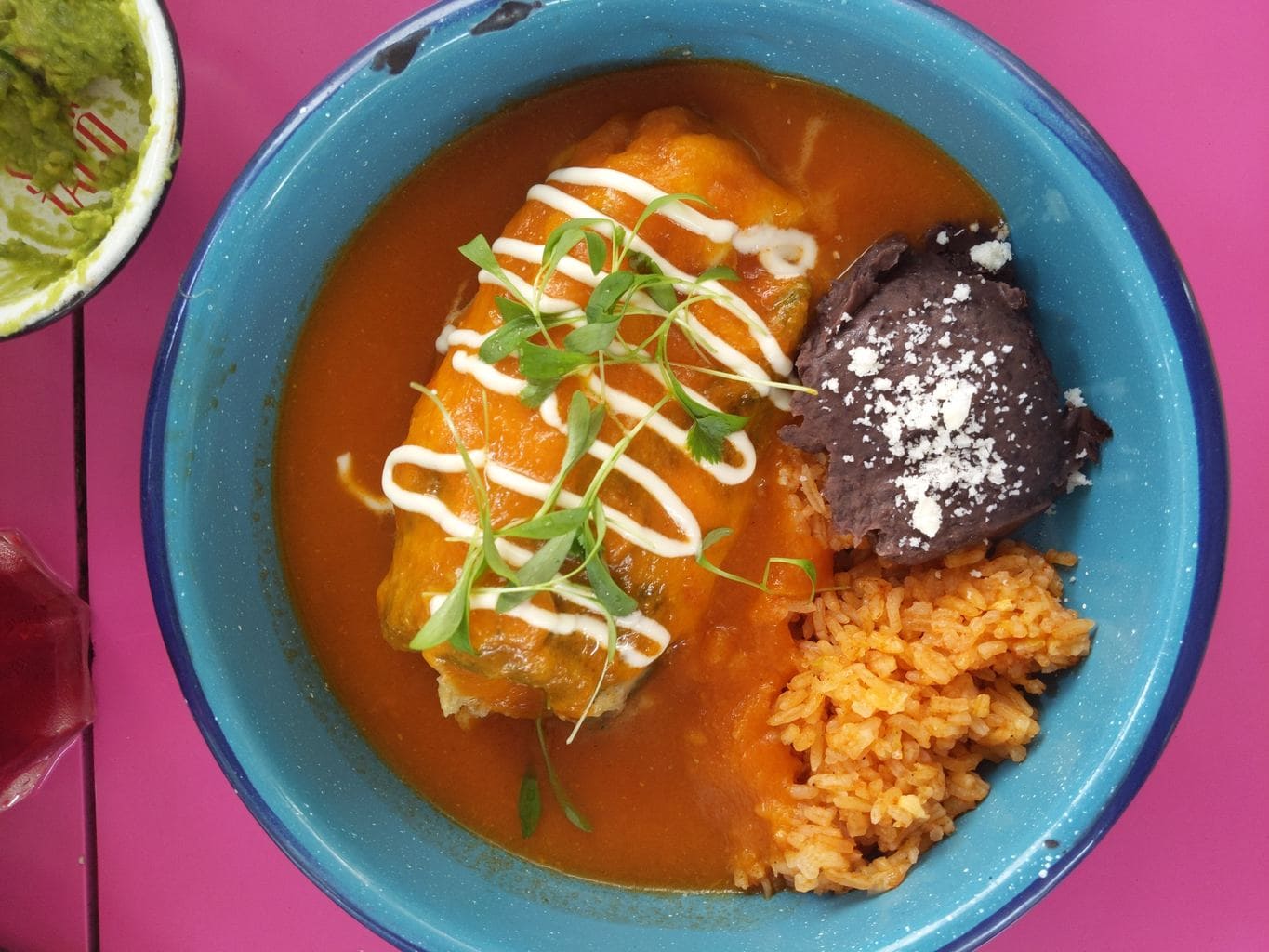
Chiles rellenos are, as the name indicates, large, stuffed and roasted poblano peppers which are typically eaten across the country. As chiles are a favorite local Mexican food, making them the star of a dish is unsurprising.
Poblano peppers are not the spicy type, but still have most of the great pepper flavor. Inside, the filling is usually made with cheese or meat and outside, the peppers are covered with egg, walnut sauce (for chiles en nogada) or tomato sauce.
Poblano peppers are from Puebla, the colonial city about 2h from Mexico City, and this is considered one of the most patriotic foods in Mexico. Remember the Mexican eggs having the colors of the flag? So does this dish.
It is, legend says, that in 1821, Agustín de Iturbide was driving back to Mexico City from Veracruz after having signed the declaration of independence from Spain when he stopped at a convent in Puebla to celebrate his Saint’s day.
The nuns decided to prepare a patriotic dish by stuffing chile peppers and covering them with walnut sauce, then sprinkled them with parsley and pomegranate seeds to add green and red to the white sauce and represent the flag.
To date, stuffed peppers are still served with the same toppings across Mexico.
Mole
One of the most iconic foods in Mexico is also one of the most difficult to describe.
Mole is not commonly found outside of Mexico as it takes time to prepare and commercial alternatives are hard to find abroad. It is also decreasingly made from scratch in Mexico because of how time consuming the process is. Even if you have eaten at a Mexican restaurant hundreds of times, you may have never even heard of it.
The term mole (where the e is pronounced as in bed) comes from the Nahuatl mulli which means sauce and were offered to the gods and the rulers in Aztec and Mayan times and so were considered a treat. Many legends surround its origin, although almost all start in a convent and include some Spanish ruler.
In today’s Mexican cuisine, the word mole refers to a wide range of thick sauces, most of which have in common the use of chilli, tomato, seeds, chocolate, onion and achiote seeds. Traditional mole is dark and has a rich texture similar to melted chocolate.
Mole can be eaten on its own as a dip, with tortillas or totopos, or as complementary sauce to a dish, usually meat and most commonly chicken or turkey. But I have also eaten it on top of bananas. Because of its sweet, salty and spicy flavor, mole can give life to any dish.
There are many types of moles, depending on the spices and condiments used, and they are usually distinguished by their origin, or their color.
The most popular types are Poblano, from Puebla, which was the original according to legend and includes several dozen ingredients including various types of chiles, nuts, seeds, herbs, onion and garlic among others.
White mole usually does not contain chocolate while green mole has pumpkin seeds and parsley. Yellow mole is made with yellow chiles. Oaxacan mole is also very famous and has a fruity flavor brought about by the fruits used in its preparation and the long list of spices and herbs.
Tlacoyo
Another traditional Mexican food from the Nahuatl tlahtlaoyotl, these blue corn masa treats are originally from Tlatelolco market, near the archeological site of the same name, in northern Mexico City, but can be found across the city and in other parts of Mexico.
This handy map shows you the street stalls selling them in the neighbourhood of San Rafael in Mexico City.
Tlacoyo are oval-shaped, usually blue corn masa snacks filled with beans, cheese, meat and other ingredients, then usually fried or cooked on a comal, the tortilla griddle, making them a pocket of goodness. They can also be topped with condiments such as avocado sauce, chilli sauce, cream, grated cheese, etc. and can be a meal in themselves.
Huarache
Not to be confused with the Oaxacan sandal of the same name which probably inspired the dish from its shape, a Huarache is a Mexican dish made with coarser toasted corn masa dough fashioned in an oval shape, filled with frijol paste, and then fried. It is traditionally topped with chilli sauce, ribs or scrambled eggs, but nowadays with anything, from fried beans to nopales, cheese, avocado, etc. It can be thought of as the white and poor man’s version of a tlacoyo.
The dish was invented by Carmen Gómez Medina in the 1930s at her sopes and tlacoyo stall in Mexico City and is still sold at one of her two food chains, El Huarache Azteca and Huarache de Jamaica (her original 1960s shop), but just as easily found around Mexico City’s Zocalo many food stalls that pop up every afternoon and evening.
Note the irregular shape of the huaraches and also, the small holes in the top part, which helped get the oil and fat to reach the bean paste filling when frying them.
Pambazo, torta ahoga and chanclas
These three Mexican foods are pretty similar, the difference lies in the type of bread, the sauce it is dipped into and the filling but the concept remains: a sandwich filled with meat and other condiments and then soaked completely into chilli and tomato sauce.
As per the names, ever so descriptive of what’s in a dish in Mexican cuisine, a torta hogada is literally a sunken sandwich, whereas a chancla is a sandal. Pambazo does not mean anything (at least in Spain), aside from a bread root (pan).
Remember that, unlike in Spain, tortas in Mexico are sandwiches. In Spain, a torta is a cake, not quite the same.
Pambazos are more typical of Mexico City while Tortas ahogadas are from the state of Jalisco, from Narcos-fame Guadalajara, picturesque Tequila, hippie Sayulita with its oceanside resorts and popular Puerto Vallarta. Chanclas is the name the dish receives in colonial Puebla.
The first time I tried a torta ahogada was in fact in Tequila, while on a Jose Cuervo factory tour. We opted for the tour with premium tequila and food tasting and what better way to enjoy a shot of tequila than with a local dish such as this.
I must admit I was skeptical when the old lady who had prepared the food started to tell us about the dish. A wet sandwich you say? And won’t it be (in typical Mexican style) super spicy hot?
But it wasn’t, and the sauce really saved an otherwise quite bland and thick bread filled to the brim with meat. You need the bread to be that way, because otherwise it would become soggy under the runny sauce and make it a whole mess. I then had it again, for lunch one day, and remembered how filling (and incredibly affordable) the dish can be.
So what is the difference between the three? Pambazo is made with smaller round bread buns while tortas ahogadas use a sort of baguette style bread (without the crunch) and chanclas are also smaller and powdered. Inside, tortas ahogadas usually have pork while pambazos have potatoes and chorizo and chanclas have usually beef.
Chemita
This might just be one of the few Mexican foods in this list that does not contain any corn, so I very much welcomed the variation the day I had it.
Chemita is not really a traditional Mexican dish, but it is nonetheless something you should eat if you find yourself in Mexico City.
This dish was invented by the Prendes Restaurant, which used to be located where the Museo de Bellas Artes is today. At one point, this is where all the who’s who of the Mexican society used to eat, from artists like Rivera to politicians. Prendes was followed by Bellinghausen which is located in the Zona Rosa till today.
Walking in is like going back in time and being surrounded by all the businessmen and high society people of Mexico City. I felt widely underdressed and slightly out of place, and the white cloth tables, white jacket waiters and dessert tray all lent it an elegant old-fashioned look.
Chemita filet is a simple beef steak in its juices with mashed potatoes and fried onions but the meat is so tender and juicy it is worth a stop for when you need a corn-free break.
Cochinita pibil
This slow roasted pork dish is one of those tasty indulging foods in Mexico that can make anyone happy. Commonly available across the country, cochinita pibil is originally from the Yucatan Peninsula and has a strong Mayan influence.
The dish looks messy and red, from the annatto seeds (achiote) which are used to marinate the meat before it is cooked together with acidic Seville type of oranges. The result is similar to pulled pork, where the meat falls off the bone and melts in your mouth.
Traditionally, the whole suckling pig (cochinita) was cooked slowly over several hours underground (pibil in Mayan) with the use of hot stones and wrapped in banana leaves.
The dish is a great example of Mayan and Spanish influences blending in to create something new, the Mayan cooking technique, used in their large feasts and celebrations, and the pork, which was brought by the Spanish.
Today, you can find cochinita pibil as a topping for tacos, for tostadas, etc. or also as a dish on its own, served off the bone, meat only. Delicious!
Sopa de tortilla
Tortillas are so common that they are even available in soup form. I was not quite sure how a tortilla soup was made so I ordered it to try one day and realised it was basically a tomato soup filled with fried tortilla chip strips.
While the soup is quite tasty, it is a bit of a tortilla overload, for me. The soup is usually topped with a bit of cream and can also have sliced avocado. It is also known as Aztec soup.
Birria
Birria is a goat or lamb stew with a rather thin broth that is traditional of the state of Jalisco. Unlike other Mexican dishes on this list, its name does not come from the Nahuatl. In Spain, birria is an adjective used to refer to things that are messy and worthless, maybe the dish’s appearance gave it its name.
It looks like a rather simple dish, usually served on terracotta bowls, with nothing more than the meat and some onions and beans, but it is quite tasty thanks to the many spices that were used to prepare it.
Spiciness can be added to taste or with the order, and chilli sauce is always available, so you can make it as hot as you like. You can also add sliced onion and lemon. Tortillas will also come with the dish, which you could if you wanted, make tacos with, but the broth is quite flavourful as well.
Traditionally, birria was a dish for special occasions but is today available at restaurants, particularly in the city of Guadalajara.
Aguachile
An aguachile is nothing more than a ceviche which can be made with prawns, octopus, fish, etc. It will almost always include generous amounts of avocado, and lots of chilli, sliced and in the marinade, making this fantastic Mexican dish refreshing if rather spicy.
I truly loved aguachile and found them one of the healthiest foods in Mexico, also a light alternative to corn-based foods, fret not, totopos or tostadas are usually served with it too, but they were quite spicy without fail, I guess the name (chilli water) is self-explanatory.
Remember the molcajete above? Aguachiles can often be served in a molcajete.
Cuitlacoche
More than a Mexican food, cuitlacoche is an ingredient that I saw in many menus across Mexico City. It refers to a sort of fungus or mushroom that grows on corn which is considered a delicacy and added as a condiment and ingredient to tacos, quesadillas and other dishes.
I could not taste much of it, as its flavor was quite mild, but if you see it on the menu you know it’s a sort of mushroom.
Nopal
Nopal is a type of cactus, the more traditional oval-shaped spiky ones that you may see across Mexico and deserts in other parts of the world. Where I come from near Barcelona, they grow wild and are usually of the same species but they are native to Mexico where there are dozens of different types.
Nopales bear fruits, called prickly pears, which are also eaten in Mexico, and the meaty soft pads are sold across the country after having their spikes scraped off and used as regular vegetables, in a similar fashion as you would a pepper. If you walk around a market, you may see them for sale in small batches wrapped with strings.
Nopales (plural for nopal) are eaten raw, boiled, steamed or even fried, then added as a topping to many dishes, from salads to tacos. They are soft and crunchy and have a slightly slimy texture so they go well with a bit of lemon. Simple nopal salads, where they act as a replacement for lettuce, are also available.
If you are looking for a rather healthy Mexican dish, nopales are a great ingredient to consider because they are low in calories and fat but high in calcium and antioxidants.
Pan de cazon
This is one of the most interesting Mexican dishes I tried, at the Anthropology Museum in Mexico City no less. A pan de cazon is a Mexican version of a lasagna and, you guessed it, instead of pasta, they use tortillas and instead of meat, dogfish, an animal of the shark family.
Pan de cazon is originally from Campeche in the Caribbean coast, where the dish is traditionally made with cazon meat, a type of shark that is considered vulnerable but not threatened and which can also be found in the eastern and southern parts of Spain.
The dish is made with three tortillas on top of each other, spread with frijol paste and separated by roasted, stewed or fried cazon meat, then topped with tomato sauce, avocado slices and slices of habanero chillies.
You can also find pan de cazon made with other proteins, mine was made with chicken. Because of the large quantity of meat, sauce, beans and tortillas, this can be a really heavy and filling dish. I could only finish half of it.
Enchiladas
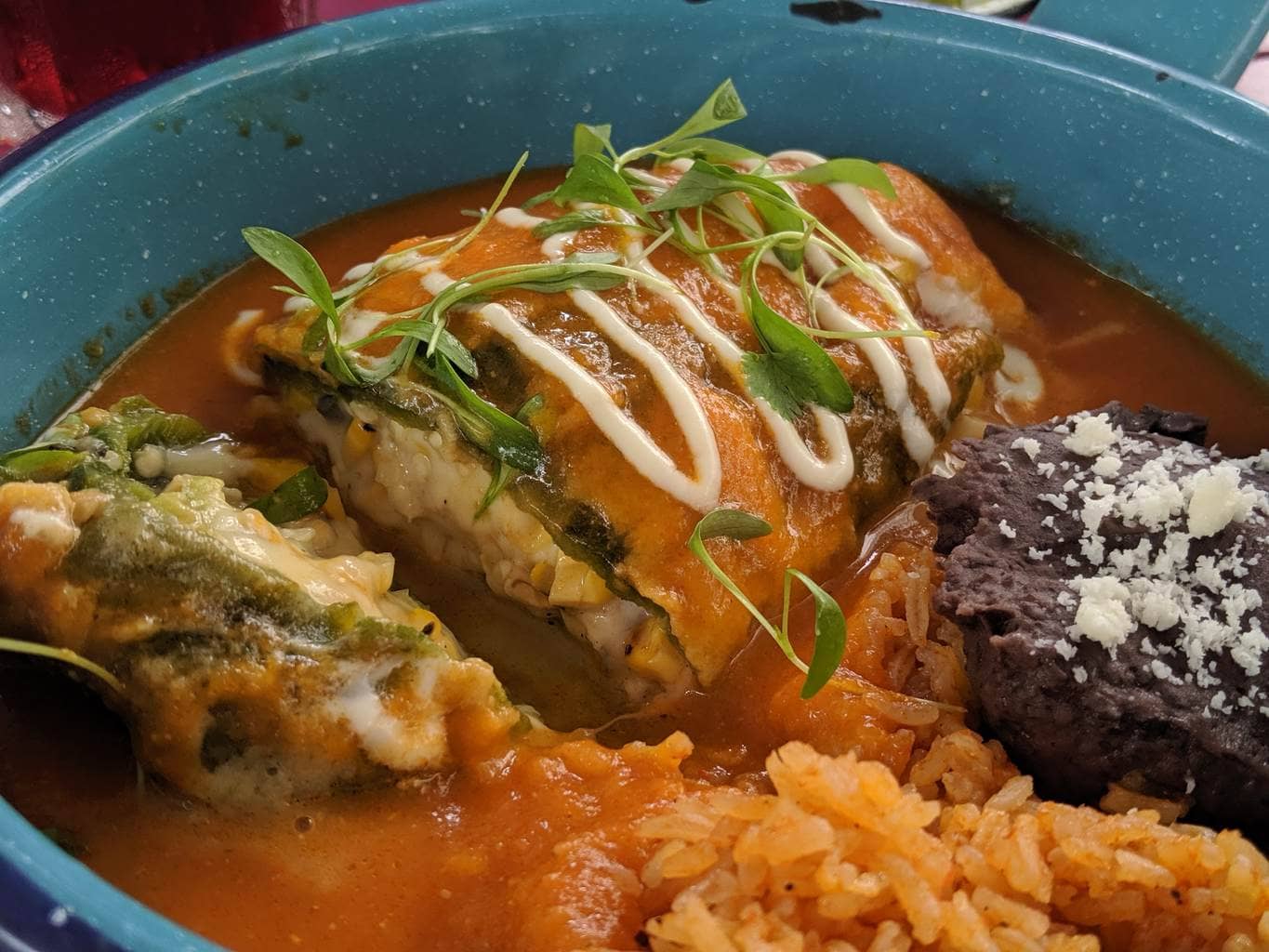
Enchiladas are another well known Mexican and versatile dish common outside the country. The word “enchilar” refers to the action of adding chilli to something, so a lot of dishes in Mexico can be eaten “in chilli” or enchiladas form.
Typically, the enchilada dish is made with rolled tortillas filled with meat (usually chicken), cheese, egg or vegetables then lightly fried and topped with sauce, cheese, chillies, etc. You will see them called enchiladas verdes (topped with green sauce), rojas (topped with red sauce) or de mole.
Enchiladas can also be topped with cheese and baked, especially in the US. The concept of an enchilada can be really wide, but will always include rolled tortillas and lots of sauce.
Food in Mexico: Mexican desserts and sweets
Mexicans definitely have a sweet tooth but you might be surprised to know there aren’t as many Mexican desserts as there are savory foods.
I also almost never had enough space for dessert after all the food that was served, and the free totopos, frijoles and other snacks that came with every meal. But if you have space for it, some of the Mexican desserts and sweets are worth every calorie.
Churros
The first item in my list of Mexican desserts is not really a dessert but it is one of the most popular Mexican sweet dishes.
Let me shatter the misconception about churros: like in Spain, Mexicans do not eat churros as dessert, they are a sweet snack, a breakfast or afternoon merienda food item but not a dessert eaten at the end of a meal.
Back in Spain, my dad would go get them from the churreria, the street stall making them, for breakfast on a Sunday, or we would have them at 5pm tea time with hot chocolate, and never see it on a restaurant’s menu.
Churros are a dish that does not require much explanation. This long, crispy fried dough topped with sugar is a treat that is hard to resist. But Mexicans take it to the next level by also eating them filled with even more indulgence: chocolate, caramel, cream, cheese, etc. and then topped with generous amounts of sugar.
If you are in Mexico City and happen to go down south to Coyoacan, you will see churros are widely available from food stalls all around the town center. You can pick the filling and the amount of sugar and buy them individually in practical small bags that make eating them mess-free.
Fruit gelatin
One of the freshest Mexican desserts is also one of the most commonly available, fruit gelatin with pieces of fruits with flavoring, is widely available from street vendors and stalls in individual portions, and you can also find it in restaurant menus.
You can find a wide range of flavors and ingredients, with fruits like oranges, papaya, etc. covered in gelatin in colorful flavors.
Buñuelos
This traditionally Spanish sweet and dessert brought by the Conquistadors is typical in Spain at the Easter and Lent periods and we eat it a lot in Catalunya, not just as dessert (sometimes covered with chocolate) but as breakfast or an afternoon snack.
The Mexican dessert version of Buñuelos change from the traditional Spanish puffed up, round ball to a flatter shape, but the sugar topping and cinnamon remains.
Flan
Flan is another Spanish dessert that made it to Mexico and which I love, especially the homemade ones.
Essentially a more consistent custard, this Mexican dessert is an egg yolk, milk and sugar treat topped with runny caramel sauce that is rather easy to make and loaded with eggs so not for those with cholesterol worries, but it is oh so good.
Flan can be made individually or as a larger cake you can slice pieces from. You can also buy it in the supermarket from the dairy section as it is a commonly eaten dessert, or order it at a restaurant, one of my most favorite indulgences.
Tres leches cake

Tres leches cake is found all over Latin America including Guatemala were it’s called pastel tres leches. It’s basically a sponge cake that is then soaked in three kinds of milk which include evaporated milk, condensed milk, and heavy cream. It is then topped with cream and ready to go! The cake can vary in sweetness and texture from velvety smooth to filled with air bubbles.
Arroz con leche
Literally rice with milk, this Spanish pudding made by cooking rice in milk and sugar with lemon rind and a cinnamon stick is one of the nicest ways to end a meal.
Also a dessert that you can find in supermarkets, arroz con leche is delicious, especially if the lemon and cinnamon flavours come through and there is not too much sugar added. It is usually served with sprinkled cinnamon powder.
Pan de elote
Well you didn’t think you could get away without having at least one Mexican dessert dish that used corn!
Pan de elote is precisely that, corn bread, and can be a rather unsweetened dessert option which would need a bit of sauce, caramel or cajeta (the Mexican version of dulce de leche) or can be really sweet if it is made with enough cream and condensed milk.
Jericallas
Very similar to a flan, this Mexican dessert from Guadalajara is thought to have been invented in the 19th century at the orphanage Hospicio Cabañas, today one of Mexico’s most impressive UNESCO sites, by a Spanish nun from Jerica in the province of Valencia.
The sweet is made with eggs, milk, cinnamon, vanilla and sugar and is very similar to the flan in look, but much runnier. In Spain we have a very similar dessert called antillas which is also sold in supermarkets like flan and is a lighter version on flan, creamier, more custardy and with less egg and more milk.
Capirotada
Another Spanish import, capirotada is a Mexican bread pudding made with stale bread, sugar, raisins, cinnamon, spices and cheese. It is a specialty of Lent and Easter but you can also find it outside of these periods. Its name refers to a friar’s hat called capirote in Spanish, because of the cheese top.
Capirotadas are different from any other types of bread puddings because of this cheese layer. Each capirotada is uniquely made depending on each chef’s recipe and the amounts of each ingredient.
Mexican drinks
The best partner to real Mexican food is a full glass of any of Mexico’s traditional drinks and trust me, they have taken the work drink to the next level.
You will not be surprised to find corn in some of the drinks. Yep, Mexicans have managed to find a way to drink it too. As well as other well known suspects like tequila.
Atole
From the Nahuatl Atolli, this warm maize drink often flavoured with cocoa was a treat for the Mayan and Montezuma is known to have sweetened it with honey. It’s texture can be a little bit off-putting at first, as it is a bit viscous, but it grows on you.
The Mayans drank it on its own but nowadays it is usually flavored and sweetened, eaten on its own or as an accompaniment to authentic Mexican food. It is not something that you can easily find in menus but more in street stalls. Although atole is usually eaten hot, as you would a cup of hot chocolate, you can also find it cold.
Horchata

Mexican horchata is not like the Spanish tiger nut milk called horchata, despite having the same name, but is equally amazing. Originally, the drink came from Spain and because of the lack of tiger nuts in Mexico, other ingredients were used instead.
Mexican horchata is a milk drink made with rice, water, sugar, vanilla and cinnamon plus a host of other nuts and seeds to the consideration of the person preparing it. The exact blend varies from chef to chef but the flavor is usually similar.
Horchata is drunk cold, usually with ice, and can be found both in street stalls as well as restaurant menus and it makes for a great summer drink.
Pulque
Pulque is a legendary, hard-to-find frothy drink that was drunk by the Mesoamerican civilisations in pre-Hispanic times. You can think of pulque as the precedent of tequila but it is even more ancient.
Because it is a mildly alcoholic (usually like beer or less) fermented drink, it needs to be drunk within a day or two from it being made so it is hard to find except for in pulquerias or local fiestas. While these were widely available before, pulque has been replaced with beer (of similar alcoholic percentage) across Mexico and pulquerias are less common these days.
I tried it at Teotihuacan, after spending a couple of hours climbing and exploring the tall dusty pyramids, and it tasted like heaven to me, thanks to the cookie flavor.
Pulque is made from the sap, the miel (honey) of the maguey plant, the ever-present aloe-vera looking (but let’s not get confused as aloe vera is a different type of plant) cactus plant that is used to make tequila and also referred to as agave.
Because of its acquired, frothy and viscous texture, pulque is not for everyone and is usually flavored with other things to make it more palatable. Some people actually find it really unpleasant and several of my tour-goers did not like it at all.
If you can try the blended version with fruits or cookies, you will thoroughly enjoy it, in its pure form, it had to remain the stuff of legends for me.
Tequila
Tequila does not need any introduction or presentation, it is a well known distilled Mexican drink famous around the world primarily drunk in shot form or as margarita. You can drink tequila with traditional Mexican food or on its own, and it is of course widely available at bars across the country.
But how much do you really know about this strong drink that usually spells hangover and blackouts?
I went on a tour of Jose Cuervo’s factory, the oldest in Mexico, and learned quite a few things I didn’t know, so let’s do a quick Trivia on this most famous Mexican drink.
Tequila is protected by designation of origin, much like Champagne can only be made in the Champagne Region, Cava in certain parts of Catalunya and feta cheese in a protected part of Greece. Tequila can only be called that if it is produced in the Mexican state of Jalisco.
In fact, Tequila is the name of a town, Pueblo Magico to be precise, which is a pretty cobblestoned colonial town about an hour from Guadalajara and the center of tequila production. I attended the wedding of a friend of mine who is from Guadalajara and it was gorgeous.
The drink should be made from the blue agave plant, but most of the commercial tequila you find in shops is not made with pure agave but with other types, because agave takes 8 years to mature and there aren’t that many.
While pulque was the pre-Columbian drink of choice, tequila was invented by the Spanish conquistadors, when they ran out of their own brandy and looked for other options to obtain a distilled drink. Its production dates back to the beginning of the 17th century and Jose Cuervo was the first to be granted a license to produce it by the Spanish King.
In order for the drink to be called tequila, it must have a minimum of 40% alcohol according to US laws, hence why the drink is so strong. The US is the largest importer of the drink.
Next time you drink tequila, do as Mexicans do and order it neat and sip it slowly. This is how it’s drunk in Mexico, not by downing a shot glass or by turning it into a margarita.
Mezcal
Tequila is the sleek brother of smoky mezcal. Unlike its more famous sibling, mezcal can be made with any type of agave, not just the blue type, and gets its name for the Nahuatl for oven-cooked agave.
This lesser famous Mexican drink is made the same way as tequila and has a similar flavor except for the smokiness. It was also a precursor to tequila and produced by the Spanish when they started to experiment with distilling agave.
While tequila comes from the state of Jalisco, mezcal comes from Oaxaca and other parts of the country and is also protected by a designation of origin. The drink is far less popular outside of Mexico, although there is an increasing “hipsterisation” of mezcal and I see it more and more in international craft cocktail menus as if it had just been discovered, despite it being over four centuries old.
Order it neat and straight.
Tejuino
Tejuino is not a very common Mexican drink and you may not come across it unless you are in Jalisco, but I found it quite interesting so wanted to add it too.
This is a Mexican fermented sugar and corn dough (same as is used to make tortillas) drink served cold and topped with a scoop of homemade lemon sorbet called nieve de limon that is usually sold by street vendors across cities like Puerto Vallarta or Guadalajara and surrounding areas.
Because of its consistency and it’s composition, tejuino is almost a meal in itself.
Michelada
Another Mexican drink I could not get my head around was the Michelada, which I also found across Guatemala.
Michelada is the Mexican version of a Bloody Mary, only it is far more complex in ingredients and composition, and it is eaten on its own or with some food.
A michelada usually includes tomato juice, salt, beer, chilli sauce, lime juice, sauces and spices. You can prepare it to your own taste, adding more or less of the condiments, but at its core it’s tomato juice and beer.
Mexicans love to drink micheladas on their own or during a meal, and they are commonly available at drinks stalls and served with enough chilli sauce to wake the dead. Be careful when drinking a michelada because the glass rim is usually dusted with chilli powder too.
Aguas frescas
Every time I sat down for food in Mexico, I ordered water, “agua”, but the answer was always “what type?”. I didn’t quite understand the question until I noticed that water in Mexico is typically flavored.
When they were asking me what type of water I wanted, they didn’t care for its temperature or for sparkling vs. still, they wanted to know what flavor I wanted my water to be.
Aguas frescas are just this, a watered down juice made with flowers, grains, herbs or fruits or all of the above, and oftentimes, with generous amounts of sugar, as if ripened, plump Mexican fruits needed any more sweetness.
You can find aguas frescas made from mint and lemon, chia and lemon, orange, grapefruit, and the most popular of them all, Agua de Jamaica, which has nothing to do with the country but with the hibiscus flower.

While most of the aguas frescas are made with juice, some of them are more of a tea. Jamaica, tamarind and horchata all involve boiling the ingredients with water before cooling it down.
Aguas frescas are always served with generous amounts of ice and sometimes premade and on display at taquerias or street stalls which have rows of colorful plastic containers filled with each drink flavor. They are drunk with food, instead of plain water, and because they are so refreshing they go down well with the spicy authentic Mexican food.
Cazuelas, palomas and cantaritos
Remember I mentioned that Mexicans drink tequila straight and neat. But there are a few alternatives to the popular margaritas that allow for tequila to be mixed with juices, and they all come from the same state as Tequila.
All three of these mixed drinks are typical of Jalisco and consist of one or many of the following ingredients: tequila, grapefruit, orange and lemon juice, fruit slices, ice, salt, Squirt (a Mexican grapefruit soda) and tequila.
Cazuela is served in a clay bowl, like the ones used to cook food, which is called a cazuela, hence the drink’s name. Usually, you can choose the amount of tequila shots you want to add and serve the drink with a ladle. Half pieces of the fruits or slices are usually left in.
Cantaritos are served as individual portions, also in clay jugs, and with a mint sprig but contain pretty much the same ingredients as a cazuela, minus the large slices/pieces of fruit.
Palomas are tequila and grapefruit juice, usually one part to three, so they can be quite strong.
Beer
Much like tequila, beer is a very popular Mexican drink commonly available in menus across the country and only growing in popularity every year since the first factory opened in 1541. Its lighter alcohol percentage when compared to tequila makes it the alcoholic drink of choice to pair with food in Mexico.
You may not know that Mexico is the world’s largest exporter of beer and the fourth largest producer, exporting 30% of its production to 180 countries. Several of the local brands are well known household beer names such as Corona or Modelo.
Craft beer is also expanding and becoming more popular and menus have started to feature lots of local craft brand names.
Carajillo
Unlike the Spanish carajillo, which is nothing more than an espresso with some cognac, brandy or whiskey (or any other spirit or liquor really, my sister loves it with Baileys), the Mexican carajillo is an elaborate coffee with liquor well shaken with ice until frothy.
Foods that seem Mexican but are Tex-Mex
Some of the most surprising things I learned in Mexico related to its food. The origin of its ingredients and the history behind them was fascinating, and there were also some shocking discoveries, like the fact that margaritas are not really a Mexican drink, despite being sold as such at every Mexican restaurant abroad.
There are also a couple other famous Mexican dishes that are not real Mexican dishes. Below is a list of these false friends.
Burritos
Burritos, the wrapped wheat flour tortillas filled with anything and everything, are not totally unknown in Mexico, but their prominence is relegated to the northern US border areas, and generally uncommon in the rest of the country.
While in the US this is one of the most widely available Mexican foods, Mexicans don’t really eat burritos, and certainly not as jam packed and bursting at the seams as they are in the US where it is common to serve them wrapped in tin foil to keep them from falling apart.
You can find a smaller fried version of a wrapped flour tortilla in some parts of the country which is referred to as chimichanga, and I also ate them as flautas in Guatemala, but burritos per se are more of a Tex-Mex dish typical of California.
Fajitas

Fajitas are not a traditional food from Mexico but a famous Tex-Mex dish made with grilled meat (generally beef) and vegetables (peppers and onions) that are stuffed inside wheat flour tortillas, usually by the diner. Side toppings of sour cream and guacamole are usually served along the grilled foods.
It is believed that the fajitas were invented by Mexican laborers in Texas farms who were paid in kind with the least valuable cuts of meat called faja.
As a dish, it was made popular by a Texan grocery worker, Sonny Falcon, popularly known as the Fajita King, who wanted to find a way to sell more of the least popular meat cuts and started to promote fajitas in the 1960s at fairs and events. He claims to have invented the name itself based on the historical anecdotes about the Mexican laborers.
Margaritas
As I anticipated above, margaritas are not really an authentic Mexican drink but rather a Tex-Mex one, and Mexicans don’t usually drink tequila in margarita form but straight and neat. This is not to say that you will not find them in menus across the country, but they surely are not as popular as everyone thinks.
There are many legends and versions of its origin, all of them from the 20th century and usually involving a famous celebrity or a bartender. A traditional margarita is made with tequila, lemon juice and triple sec and served in a wide cocktail glass similar to the ones used for martinis, with salt on its rim and a slice of lime.
Don’t forget to Pin this to your Food Around the World board!


- Check if you need a visa, get help processing it at iVisa.
- Never ever leave without travel insurance. Get affordable coverage from World Nomads or long term insurance from Safety Wing.
- I find all of my flights on KAYAK. Check their Deals section too.
- Search for all your transportation between destinations on the trusted travel booking platform Bookaway.
- I book all my day trips and tours via GetYourGuide, they are the best and their tours are refundable up to 24h in advance.
- Get USD35 off your first booking with Airbnb.
- Compare hotels EVERYWHERE at HotelsCombined and book with Booking.com.
- Compare car rental prices at Rentalcars.com

